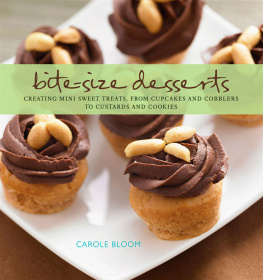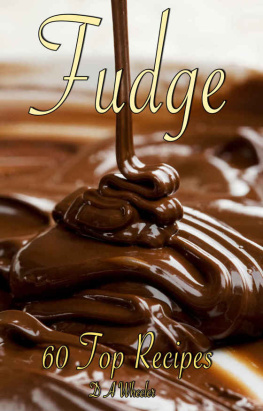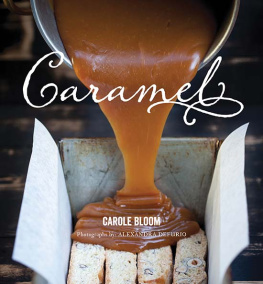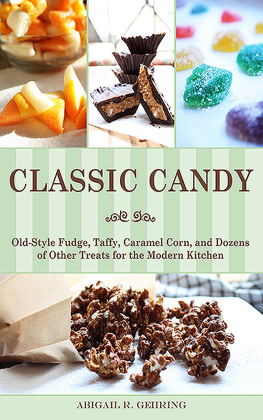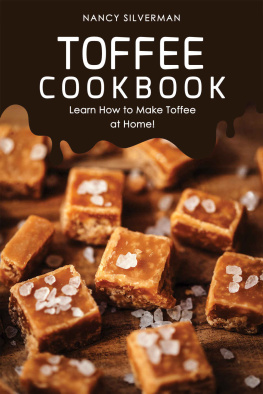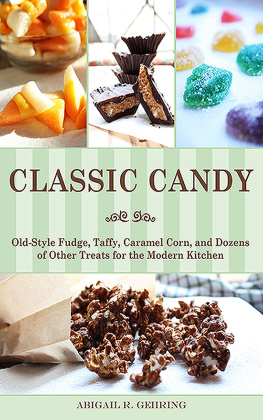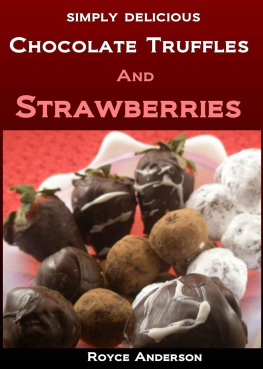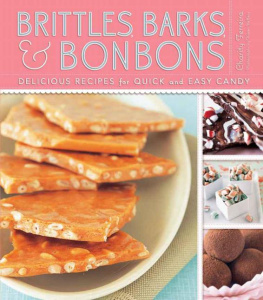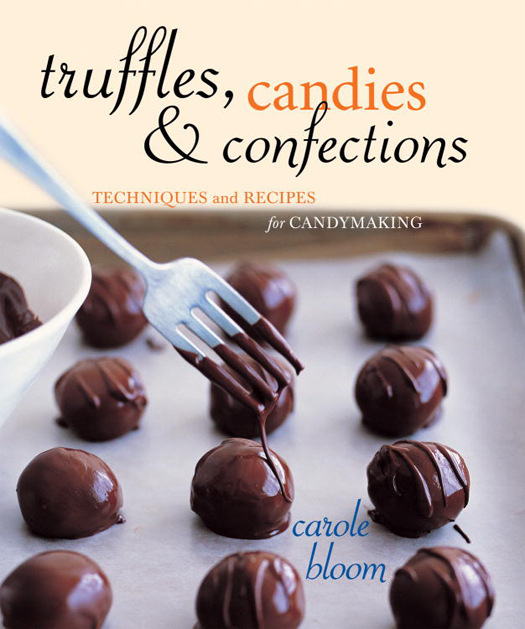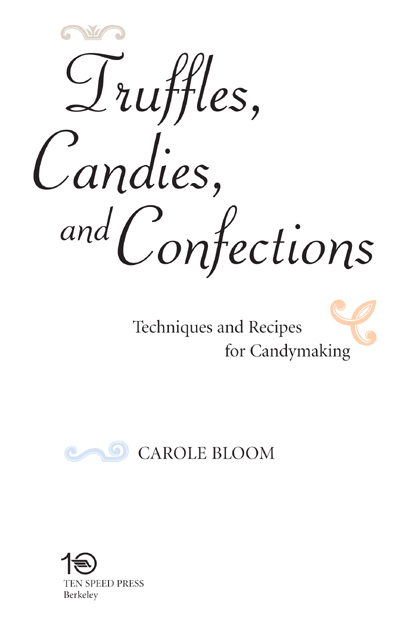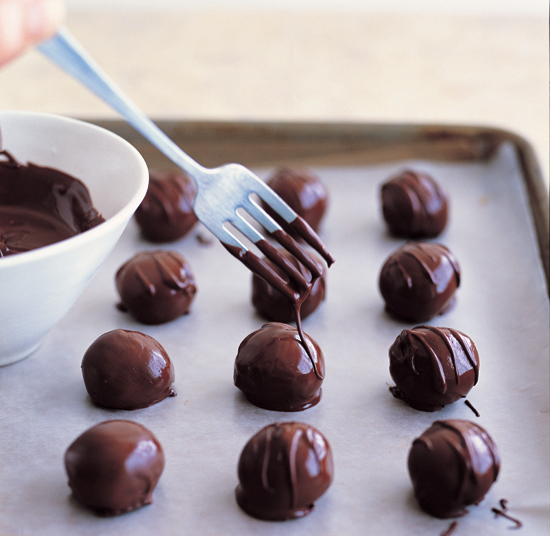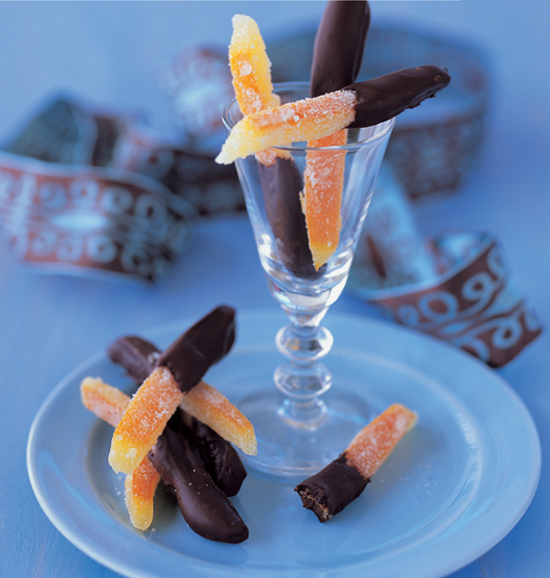Copyright 1992, 2004 by Carole Bloom
Photography 2004 by Sheri Giblin
Illustrations copyright 1992 by Amy Sibiga
All rights reserved. Published in the United States by Ten Speed Press, an imprint of the Crown Publishing Group, a division of Random House, Inc., New York.
www.crownpublishing.com
www.tenspeed.com
Ten Speed Press and the Ten Speed Press colophon are registered trademarks of Random House, Inc.
Library of Congress Cataloging-in-Publication Data
Bloom, Carole.
Truffles, candies, and confections : techniques and recipes for
candymaking / Carole Bloom.
p. cm.
Includes index.
1. Candy. I. Title.
TX791.B6523 2004
641.853 dc22 2004010545
eISBN: 978-0-307-79130-6
Cover design by Jeff Puda
Photography by Sheri Giblin
Photo assistance by Selena Aument
Food styling by Dan Becker
Prop styling by Leigh No
v3.1
D EDICATION
This book is dedicated with love to my husband, Jerry,
and to my mother and the memory of my father.
A CKNOWLEDGMENTS
My biggest thanks go to my husband, Jerry Olivas, who is a constant source of support, help, and encouragement. He is always there for me no matter where I am. During the writing of this book he ran to the store for a needed ingredient, washed dishes and cleaned up the kitchen after a busy day of recipe testing, and, certainly, tasted the days work. His creativity is an inspiration and he has a great flair for finding just the right word when needed. Also, his computer knowledge is invaluable. Without his help and support throughout the process, this book would not exist.
Thanks to my dear friends and colleagues Lily Loh and Kitty Morse for their constant encouragement, and for letting me bend their ears and use their shoulders to lean on when needed. Thanks, also, to Betz Collins for her valuable suggestions.
Thanks to Lorena Jones, editorial director of Ten Speed Press, for giving me the opportunity to revise and update my book. Im delighted to be able to share more of my knowledge and inspirations with other truffle and candy lovers. And thanks to my project editor, Meghan Keeffe, for taking such great care of my book during production.
Many thanks to Robert Steinberg of Scharffen Berger Chocolate Maker, Bernard Duclos of Valrhona Chocolate, Pierrick Chourand representing Michel Cluizel Chocolate, Gary Guittard of Guittard Chocolate, Rand Turner of El Rey Chocolate, and Y. Hans Baumann representing Felchlin Chocolate for providing me with their excellent chocolates to use in developing and testing the recipes in this book.
My mother, Florence Bloom, is excited about my work and brags about me to all her friends. Thanks, Mom! My father, Milton Bloom, always believed that I could do anything I wanted to do. He was a great candy lover. If he were here, he would be very pleased to see this book.
Contents
Introduction to the First Edition
This book is about pleasure. The pleasure of making and eating truffles, candies, and confections. Anyone can go to the store and buy something to satisfy their craving for candy. But what is bought most likely has been mass producedit wont be fresh, it will have been made with artificial additives, and it wont taste nearly as good as if it were homemade. The recipes in this book make it easy and fun to create what may well be the most delicious homemade truffles, candies, and confections you have ever eaten.
When it comes to eating something sweet, candy tops the list for most people, myself included. I have fond childhood memories of buying and eating candy from the neighborhood candy store. Standing in front of the counter and trying to make a choice was difficult, but fun. The clear glass shelves were stocked with all manner of candiessome wrapped in colorful foil, some stacked high on trays, some glistening in jars. My favorite candies were round red licorice coins. They were chewy and lasted a long time. As I got older my tastes changed, and chocolate became my great love, the darker the better.
My professional experience in the culinary field began in the early 1970s as I was completing my bachelor of arts degree in fine arts from the University of California, Berkeley. I worked as a cook in several small gourmet restaurants in Berkeley. Although I enjoyed all types of cooking, I especially liked making desserts. I decided that I would specialize in desserts and traveled to Europe to study and work.
In Switzerland I saw and ate some of the worlds finest truffles, candies, and confections, and I was determined to create them myself. One confectionery shop that really excited me was Sprngli on Paradeplatz in Zurich. Everything in their display windows was picture-perfect and everything tasted as good as it looked.
As a pastry chef, I perfected the art of making these delights. I have been able to share these skills teaching classes on truffles, candies, and confections. I have taught my students how to easily and quickly make wonderful sweets. I stress the need to use the best ingredients and equipment, and the correct techniques. My students have praised me for the clarity of my recipes and for teaching them the simplest way to create the best sweets.
The difference between truffles, candies, and confections can be confusing. These terms are related and often used interchangeably. A truffle is a type of candy or confection with a soft chocolate center surrounded by an outer coating of either chocolate, cocoa powder, or chopped nuts. Candy usually refers to brittles, toffees, and other hard sweets, whereas confections can be thought of as a general category of sweets other than truffles and hard candies. However, the word confection is commonly used in reference to truffles, candies, and a host of other sweet treats. This includes molded candies, caramels, marzipan, fudges, nougats, divinity, candied fruits, and other fruit candies. One similarity that truffles, candies, and confections have in common is that all except for candy bars are small enough to be consumed in one or two bites. Also, all are sweetened in some way, usually with sugar.
The art of making candies and confections is an ancient one. Honey was the first sweetener, used long before sugar. The crusaders brought sugar back with them from their journeys to the Holy Land in the early Middle Ages. It was a highly prized substance that did not come into widespread use until the early seventeenth century. Its interesting to note that the word candy comes from the Arabic word for sugar, qand .
When making candies and confections, always be sure to read the entire recipe first so that you will know what ingredients and equipment are necessary, and what techniques are to be used. It is a good idea to measure out all the ingredients and set out all the equipment before beginning to prepare the recipe. Proportions are very important, so be sure to measure ingredients accurately.
It is fun and creative to make truffles, candies, and confections on your own, but group candymaking can be even more fun. This is a great way for family and friends to get together for a good time and to enjoy some delicious goodies. It is an ideal way to introduce children to the tradition of family candymaking.


